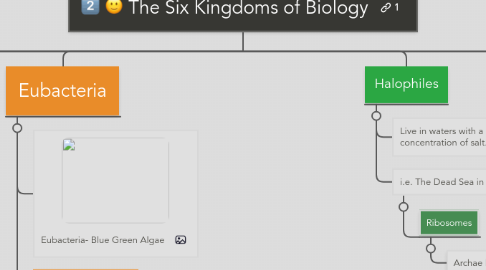
1. A
2. Animalia
2.1. Animalia- Owl
2.2. Multicellular and Eukaryotic
2.2.1. Their cells do not have a cell wall like those of the plants or fungi.
2.2.1.1. Animal cells use oxidation phosphorylation as their method of cell respiration. They require Oxygen for this process. however, they can do fermentation in the absence of oxygen.
2.2.2. Most animal cells are organized into tissues that have a particular function.
2.2.3. These tissues are organized into organs and organ systems that perform a variety of complex functions.
2.2.4. Animals reproduce both sexually and asexually.
2.3. Motile and Heterotrophic
2.3.1. Motile: (of cells, gametes, and single-celled organisms) capable of motion.
2.3.2. Heterotrophic Organisms: Organisms that can only use organic materials as a source of food. Cannot create their own food using carbon based sources.
2.4. Specialized Sense Organs
2.4.1. Animals have developed specialized sensory organs (eyes, ears, noses, skin, etc.) that help them navigate through their environment.
2.4.2. Ribosomes
2.4.2.1. Animal cells have Eukaryotic ribosomes.
3. Protista
3.1. Protista- Bacteria
3.2. Unicellular, Colonial and Multicellular
3.3. Multicellular: An organism consisting of many cells.
3.4. Colonial: Protists that live in colonies.
3.5. Unicellular: An organism that consists only of one cell.
3.6. Absorb, Ingest or Photosynthesize
3.6.1. Wide diversity in strategies for obtaining energy and carbon. i.e. Ciliates are animal like and move and hunt for food.
3.6.2. Slime molds behave like fungi and obtain nutrients from decomposition.
3.6.3. Algae photosynthesize like plants.
3.6.3.1. Protists are Eukaryotic so they have eukaryotic ribosomes.
3.6.3.1.1. Protists can reproduce sexually and asexually
3.6.3.2. protists do cellular respiration through oxidative phosphorylation or aerobic or anaerobic respiration
4. Fungi
4.1. Fungi- Mushroom
4.1.1. Ribosomes
4.1.1.1. Fungi have eukaryotic ribosomes
4.1.1.1.1. reproduction
4.2. Sessile
4.2.1. Incapable of moving on their own.
4.2.2. They can form enormous mats, known as mycelia, in the soil that can cover large areas.
4.3. Heterotrophic
4.3.1. Cannot make its own food from light or inorganic molecules.
4.3.2. It ingests its organic molecules by feeding on other organisms or the remains of other organisms.
4.3.3. They digest their food externally and then absorb the nutrients.
4.3.3.1. they create ATP by fermentation and aerobic respiration.
4.4. Mostly Multicellular
4.4.1. Yeasts are single celled, but are considered to have evolved from multicellular forms.
4.4.2. Fungi aid in the recycling of nutrients by the decomposing of dead plants and animals.
4.4.2.1. Have cell walls made of chitin. This is the same material insect exoskeletons are made out of.
5. Eubacteria
5.1. Eubacteria- Blue Green Algae
5.2. Streptococcus
5.2.1. Spherical bacteria have many dangerous species that are responsible for strep throat, meningitis, bacterial pneumonia, etc.
5.2.2. Many streptococcal special are non-pathogenic and used for Swiss cheese, and exist as a natural part of the natural floral in humans' mouth, intestine, respiratory tract and on human skin.
5.3. Preform Photosynthesis
5.3.1. Capture energy from the sun using photosynthesis.
5.3.1.1. do cellular respiration but not oxidative phosphorylation
5.3.2. Add oxygen to the atmosphere through this process of photosynthesis.
5.3.2.1. they also do cellular respiration through aerobic and anaerobic respiration.
5.3.3. Methanogens
5.3.3.1. Live in an oxygen-free environment and produce Methane gas.
5.3.3.1.1. without oxygen, these organisms must create ATP by doing fermentation.
5.3.3.2. Found in marshes, lake sediments, and digestive tracts of animals.
5.4. Complex, Prokaryotic and Single-Celled Organisms
5.4.1. Prokaryotic cells do not have a nucleus or membrane-bound organelles.
5.4.1.1. Ribosomes
5.4.1.1.1. They have prokaryotic ribosomes
6. Halophiles
6.1. Live in waters with a very high concentration of salt.
6.2. i.e. The Dead Sea in the Middle East
6.2.1. Ribosomes
6.2.1.1. Archae have prokaryotic ribosomes
6.2.1.1.1. reproduction
7. Archaebacteria
7.1. Archaebacteria- Thermophile
7.2. Thermophiles
7.2.1. Live in hot areas where the water is a very hot and acidic sulfur spring.
7.2.2. Autotrophic Producer: Synthesizes its own food from inorganic substances using light or chemical energy.
7.2.3. Anerobic and thrives in the deep cracks of the ocean floor.
8. Plantae
8.1. Plantae- Palm Tree
8.2. Autotrophic
8.2.1. Unlike heterotrophs, autotrophs are able to make their own food.
8.2.2. Plants belong to the class of autotrophs called photoautotrophs because they make their food from sunlight through the process of photosynthesis.
8.3. 7
8.3.1. Like animals, plants have a variety of tissues and organs that perform vital functions for the organism.
8.3.2. i.e. The leaf is made up of several different tissues and is the primary food producing organ of higher plants.
8.4. Multicellular and Eukaryotic
8.4.1. Plant cells are surrounded by a cell wall made composed of cellulose that provides support to the plant, and allows them to grow to great size.
8.4.1.1. Ribosomes
8.4.1.1.1. plants have eukaryotic ribosomes
